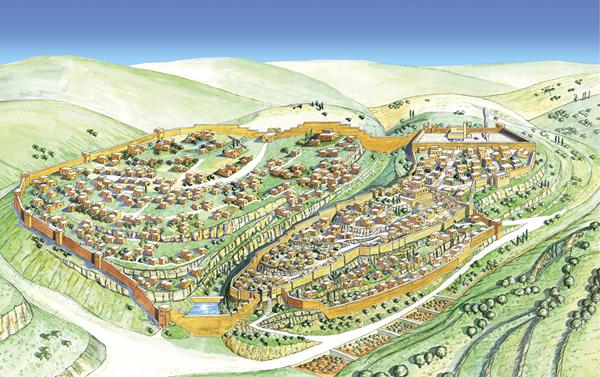The reconstruction of the ancient walls surrounding Jerusalem marks a significant period in the city’s storied history. The action of rebuilding these fortifications catalyzed not only a physical transformation of the landscape but also triggered an array of social, political, and spiritual changes that reverberated through subsequent generations. Understanding the context and consequences of the wall’s reconstruction provides a fertile ground for exploring how urban infrastructures can manifest broader cultural narratives and influence collective identity.
Initially erected during the reign of King Hezekiah, Jerusalem’s walls served as a bulwark against siege and invasion, a function they retained throughout their tumultuous history. However, their obliteration during various conquests necessitated periods of reconstruction that profoundly altered the socio-political fabric of the city. After the wall around Jerusalem was rebuilt, we witness a fascinating interplay of developments that shaped the character of Jerusalem as a focal point of religious devotion and political intrigue.
The first consequence of the wall’s reconstruction was the re-establishment of Jerusalem as a center of governance. Following the Babylonian exile, the wall signified not merely a physical protection against external aggression but also an affirmation of the city’s autonomy. The fortified structure provided the necessary confidence for Jewish leaders, such as Ezra and Nehemiah, to facilitate the return of exiled populations. Through this reintegration, Jerusalem emerged as a site of renewed self-governance, reflecting an emergent sense of identity among the Jewish people.
Moreover, the fortification of the city catalyzed economic revitalization. With the establishment of security, trade routes once again flourished. Merchants, previously wary of traversing the region due to ongoing unrest, were invigorated by the newfound tranquility provided by the walls. The bustling marketplace of Jerusalem, resplendent with exotic goods and local produce, began attracting not only local commerce but also pilgrims from various parts of the ancient world. In essence, the wall functioned as a conduit for economic exchanges that solidified Jerusalem’s prominence as a commercial hub.
Alongside these practical implications, spiritual revitalization emerged as a prominent theme following the wall’s reconstruction. Walls have historically held symbolic significance, and in Jerusalem, they served as a physical reminder of divine protection and the covenant between God and His people. The re-establishment of the wall reinvigorated hope within the population, projecting an image of divine favor. Public worship and rituals surged in frequency and fervor, as communities gathered to celebrate their resilience. The wall not only protected but also embodied aspirations for spiritual renewal and collective memory, thereby intertwining faith with the city’s identity.
The political ramifications of rebuilding Jerusalem’s walls cannot be overstated. The fortifications were a signal to neighboring regions that Jerusalem was reasserting its place on the geopolitical landscape. Emissaries and rulers took note, leading to a reconfiguration of alliances and hostilities. The city’s physical presence became a statement of permanence and resilience. Consequently, Jerusalem was no longer seen as merely a city caught between two worlds but emerged as a pivotal player in the regional politics of the time.
Culturally, the reconstruction marked the dawn of a renaissance. The revived walls of Jerusalem became a backdrop against which significant literary and artistic endeavors flourished. As the city’s populace grappled with their historical narratives, the literary canon began to reflect a burgeoning appreciation for cultural heritage. Scholars and scribes, emboldened by their access to a safer environment, chronicled events, myths, and prophecies. As a result, the walls underpinned a burgeoning sense of cultural pride and continuity.
Furthermore, the rebuilt wall served as a critical focal point in the emergence of various sects within Judean society. As Jerusalem became a magnet for religious interpretation, divergent views of faith flourished, leading to the formation of distinct religious sects such as the Pharisees and Sadducees. This religious diversification created an intricate tapestry of belief systems, each vying for influence within the community. The walls encircled a dynamic dialogue defined by collaboration and conflict, which ultimately shaped the theological landscape of the region for centuries to come.
Yet, the reconstruction of Jerusalem’s walls was not solely a catalyst for positive developments. The newfound security also bred isolationism. As the city fortified its defenses and its inhabitants grew walled off from the outside world, tensions with neighboring regions intensified. This exclusionary posture straddled the fine line between community cohesion and antagonism towards outsiders, thereby perpetuating a climate of distrust that could escalate into territorial disputes.
In understanding the ramifications of the wall’s reconstruction, it becomes evident that the edifice was emblematic of a society grappling with its identity and aspirations. The realities of governance, commerce, spiritual renewal, political transformation, cultural flourishing, and internal conflict all converged around the significance of the fortified walls. Each element played a critical role in crafting a legacy that continues to resonate in religious, cultural, and historical consciousness today.
In conclusion, the rebuilding of the walls around Jerusalem was far more than a mere restoration of physical barriers. It acted as a prism through which the complexities of identity, faith, governance, and societal structures were refracted. The reverberations of this historical moment extend beyond its immediate effects, inviting ongoing exploration and reflection on the interplay between architecture and collective human experience. As Jerusalem stands today, steeped in layers of history, the walls remain a silent witness to the myriad stories of resilience, conflict, and aspiration encapsulated within their embrace.
